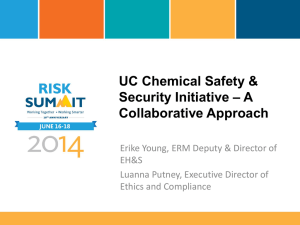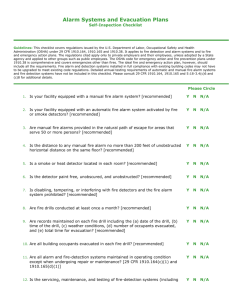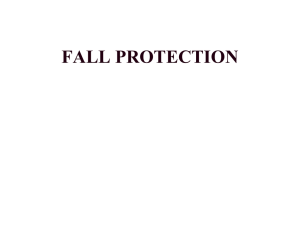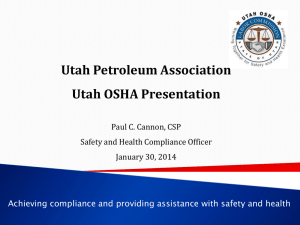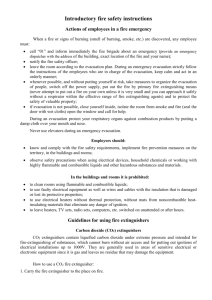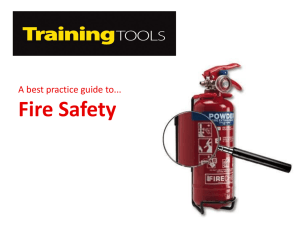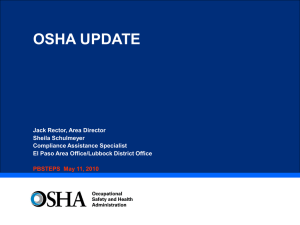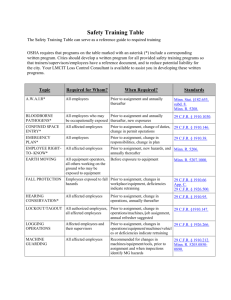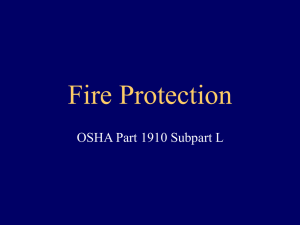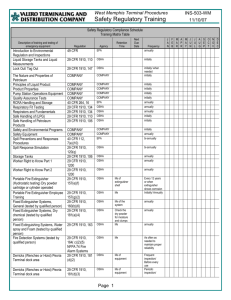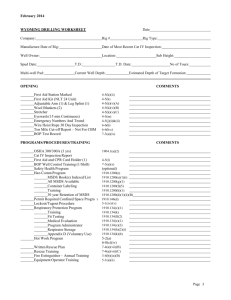Emergency Action Plan - South Dakota State University
advertisement
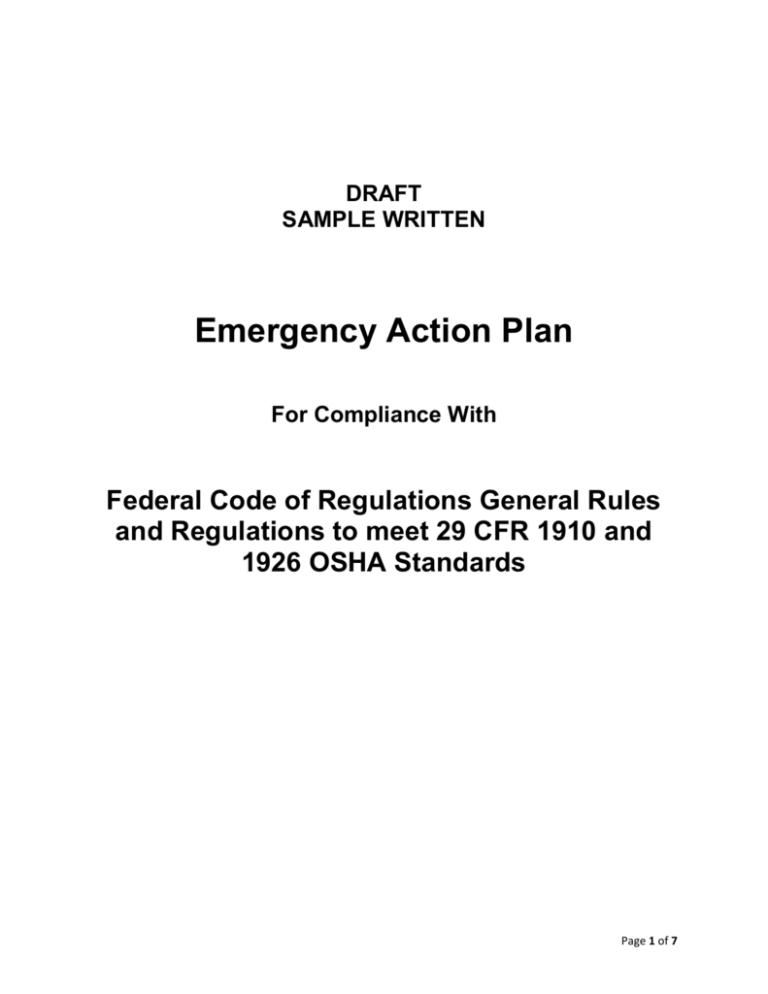
DRAFT SAMPLE WRITTEN Emergency Action Plan For Compliance With Federal Code of Regulations General Rules and Regulations to meet 29 CFR 1910 and 1926 OSHA Standards Page 1 of 7 ACKNOWLEDGMENTS This material was compiled by the staff of the South Dakota OSHA On-Site Consultation Program. NOTE: this sample plan is provided only as a guide to assist in complying with Federal OSHA's General Rules and Regulations. It is not intended to supersede the requirements detailed in the guidelines. Employers should review the standard for particular requirements which are applicable to their specific situation. Employers will need to add information relevant to their particular facility and industry, and types of machine(s) and/or system(s), in order to develop an effective program. Employers should note that certain programs are expected to be reviewed at least on an annual basis and updated when necessary. This material and Safety and Health Consultation Services are provided free of charge to owners, proprietors, and managers of small businesses, by the South Dakota On-Site Consultation Program, Engineering Extension, South Dakota State University, a program funded largely by the Occupational Safety and Health Administration (OSHA), an agency of the U.S. Department of Labor. The information contained in this document is not considered a substitute for any provision of the standard. UPDATED: February 2014 Page 2 of 7 GUIDE TO COMPLIANCE WITH THE FEDERAL 29 CFR 1910 AND 1926 EMERGENCY ACTION PLAN STANDARD This program is intended to inform the employees of this facility on emergency evacuation procedures. This plan is intended to familiarize the employees on the following elements should the aforementioned event occur. 1. Emergency escape procedures and emergency escape route assignments. 2. Procedures to be followed by employees who remain to perform (or shut down) critical plant operations before evacuating the premises. 3. Procedures to account for all employees after emergency evacuation has been completed. 4. The preferred means for reporting fires and other emergencies. 5. Names of persons to be contacted for further information of duties under the plan. Training will be conducted so employees are familiar with Emergency Action Plan. The plan will be reviewed at the following times: A) Immediately when the plan is developed; B) When employees’ responsibilities or designated action under the plan change. C) When the plan is changed. Based on the performance of an annual mock evacuation, additional training may be required. Emergency escape procedures and emergency escape route assignments: A) A map showing emergency escape routes will be posted in the following locations: 1. 2. B) All employees should familiarize themselves with the emergency routes and emergency exits. All exits and doors will be marked in accordance with 29 CFR 1910.38. The map will also denote bulk chemicals storage areas, and tornado shelters. Every exit must have the word “EXIT” in plain legible letters not less than six inches high with the strokes of the letters not less than 3/4 inch wide. Page 3 of 7 The visibility of the sign must not be impaired by decoration, furnishings, or other signs. Doors, passageways, or stairways, which are neither exits nor ways to an exit, but may be mistaken for an exit, must be clearly marked “NOT AN EXIT”, or marked with a sign indicating their actual use, e.g. “STORAGE ROOM,” or “TO BASEMENT”. In areas where the direction to the nearest exit may not be apparent, an exit sign with a directional arrow must be used. Exit signs must be illuminated by a reliable light source if occupancy is permitted at night, or if normal lighting levels are reduced at times during working hours. 1. Employee procedures to be followed by employees who remain to perform (or shut down) critical plant operation before evacuating the premises. A) Each department will have a list posted of shut down procedures in event of an emergency. These lists will be posted in a conspicuous location in each department. All employees should familiarize themselves with these procedures. Each employee will be responsible for her/his equipment and/or area: Production: ____________ ____________ 2. Procedures to account for all employees after evacuation have been completed. A) Department foreman will be responsible for a head count once assembled outside the building. A list of missing employees should be developed and presented to management person. 1. A sign will be posted next to shut down procedures. The sign will read as follows: EMERGENCY ACTION PLAN Individuals responsible for head count in an emergency. Area: Production TIME: INDIVIDUAL It is __________’s responsibility to see that this list is current and accurate. B) When an emergency message is heard the individuals listed in 2 A), should immediately congregate at this time ___________ or ___________ or any individual announcing the emergency will inform these two individuals about pertinent information concerning the emergency. These individuals should then develop a plan for safe evacuation of the employees in their respective areas. Page 4 of 7 C) Special Concerns 1. Major catastrophic event In the case of a major fire, all employees should immediately exit the building and go to one of the designated meeting areas outside the facility. 2. Tornado In event of a tornado, all employees should immediately seek shelter nearby or go to the location for tornado warning. 3. Chemical Spills In event of a chemical spill or leak, employees should immediately notify ______________. This individual should refer to chemical spill and containment procedures. 3. The preferred means of reporting fires and other emergencies: A) Individuals noticing the emergency should contact _________________. 1. The word “Emergency” followed by the nature of the emergency should be repeated several times verbally. B) Contact Fire Department or other emergency services. 1. If fire cannot be controlled using a fire extinguisher, contact the local fire department or dial 911 immediately. 2. Emergency telephone numbers will be posted next to all telephones. 3. _____________ or ____________ should make first contact with emergency vehicles and personnel. Pertinent information and the map contained with this plan should be given to the emergency official in charge. 4. Names of personnel to be contacted for further information and duties under the plan: ________________ Home:________________ ________________ Home:________________ Page 5 of 7 5. Additional Resources for review on this subject: A) OSHA Fact Sheet No. OSHA 89-19, Responding to Workplace Emergencies 1. 2. 3. 4. 5. 6. Planning Chain of Command Emergency Response Teams Response Activity Training Issues Medical Assistance. B) 1910.157 (Portable Fire Extinguisher Options) The following are several options an employer can select from to comply with the OSHA Fire Protection Standards, 29 CFR 1910.157: Option 1 - Employer elects to provide fire extinguishers that are not intended for use by employees and the employer has an Emergency Action Plan and a Fire Prevention Plan meeting the requirements of 29 CFR 1910.38, then only paragraph (e) and (f) of 29 CFR 1910.157 would apply. Option 2 - Employer elects to establish an implement a written fire safety policy which requires the immediate and total evacuation of employees from the workplace upon sounding of a fire alarm signal. In the event, that fire extinguishers are not available in the workplace, the employer would be exempt from all requirements of 29 CFR 1910.157, unless a specific standard in part 1910 requires portable fire extinguishers be provided. Option 3 - Employer has an Emergency Action Plan meeting the requirements of 29 CFR 1910.38 which designates only certain employees authorized to use the available portable fire extinguishers. This plan will also designate all other employees in the fire area to immediately evacuate upon sounding the fire alarm. The employer is exempt from the requirements in Paragraph (d) of 1910.157. Option 4 - Employer elects to permit all employees in the workplace to use portable fire extinguishers to fight fires. Employer would have to comply with 29 CFR 1910.157, Sections (c) through (g). C) Frequently Violated Regulations - Fire Protection Portable Fire Extinguishers must: 1. 2. 3. 4. Be kept fully charged and in their designated places. Be located along normal paths of travel. Not be obstructed or obscured from view. Not be mounted higher than 5 feet (to top of the extinguisher) if 40 pounds or less, or 3 ½ feet if heavier. Page 6 of 7 5. Be inspected by management or a designated employee at least monthly to ensure that they: a. Are in their designated location. c. Have not been tampered with or actuated. d. Do not have corrosion or other impairment. 6. Be inspected yearly, and / or recharged or repaired to insure operability and safety. A tag must be attached to show the maintenance or recharge date and signature or initials of the person performing the service. 7. Be hydrostatically tested. The extinguisher sales representative usually will perform this service at appropriate intervals. 8. Be selected based on type of hazard, degree of hazard, and area to be protected. 9. Be placed so that the maximum travel distances, unless there are extremely hazardous conditions, do not exceed 75 feet for Class A or 50 feet for Class B. Make sure to refer to the manufacturer’s specifications on fire extinguisher. D) Remember to attach a map of the workplace and show: 1. 2. 3. 4. Emergency pathways Gathering point(s) for fire emergency Gathering point(s) for tornado emergency Other vital information per your specific work locations and potential for emergencies Page 7 of 7
